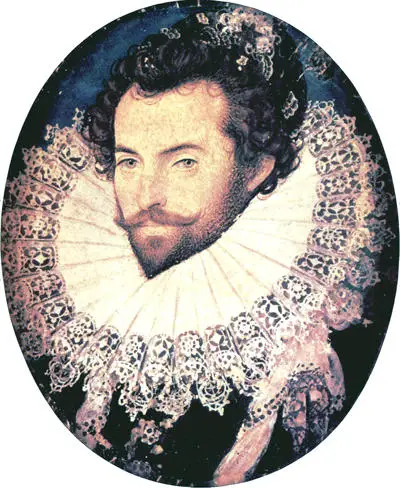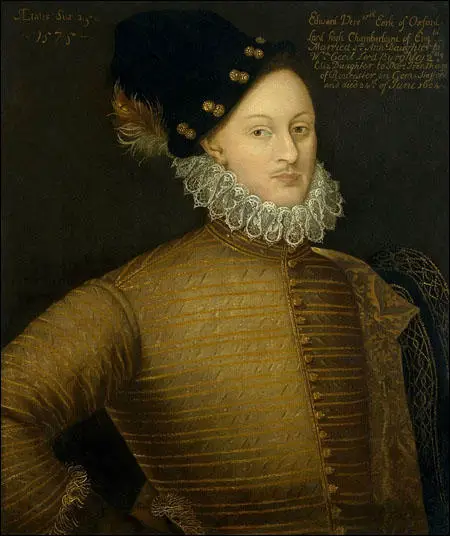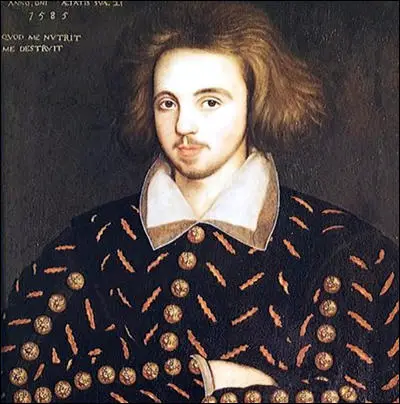Atheism in Tudor England
Atheism is the belief that God does not exist. (1) By the time that the first Tudor king came to the throne in 1485 it had firmly established the law that heretics (people who maintain beliefs contrary to the established teachings of the Church) should be burned alive. Henry VII was a fairly tolerant ruler and it was over nine years before he ordered his first heretic to be burnt. On 28th April 1494, Joan Boughton, a woman in her eighties, was burnt at the stake at Smithfield for being a follower of John Wycliffe. (2)
The main cause of heresy in Tudor England concerned the dispute over the doctrine of transubstantiation. According to the teaching of the Catholic Church, the bread and the wine used in the sacrament of the Eucharist become in actual reality the body and blood of Christ. In May 1511 six men and four women, from Tenterden in Kent, were denounced as heretics for claiming that "the sacrament of the altar was not the body of Christ but merely material bread". They were all tried as heretics and they all recanted. However, two of the men had recanted before and so were burnt at the state. (3)
Henry VIII was a more energetic hunter of heretics and an estimated 81 people were burnt at the stake. However, it was his daughter Mary, who had the worst reputation for dealing with religious non-conformity. During her three year reign 227 men and 56 women were burnt for heresy. (4) This compare to only 81 heretics executed during the reign of Henry VIII (1509-1547). Mary's cruelty resulted in her being called "Bloody Mary". John Foxe, one of the first historians to write about Mary, claimed that she was an example of what could happen when "a lawful ruler was seduced by the Devil". (5)
Henry's other daughter, Elizabeth, took a very different view about the problems of heretics. During her reign of forty-five years only six heretics were burnt at the stake. These were radical Protestants known as Anabaptists. (6) Some of her officials believed she was too tolerant in her approach to religious non-conformity.
The Walter Rayleigh Group
In 1591 Robert Persons, a Catholic priest, published Responsio. Published first in Latin, over the next two years it went through eight editions in four languages. He alleged that William Cecil and other Privy Councillors lived as "mere atheists, and laughing at other men's simplicity in that behalf". Persons also claimed that Walter Raleigh was the leader of these atheists. "There is a flourishing and well known school of Atheism which Sir Walter Raleigh runs in his house, with a certain necromancer as teacher." It then went on to predict that some day an edict might appear in the Queen's name in which belief in God would be denied. (7)

According to Paul Hyland, Raleigh was the leader of "a collection of thinkers, tightly knit or loosely grouped, whose passion was to explore the world and the mind". The group included the geographers, Richard Hakluyt and Robert Hues, the astrologer, Thomas Harriot, the mathematician, Walter Warner, and the writers, Christopher Marlowe, Thomas Kyd, George Chapman and Matthew Roydon. The men would either meet at the homes of Raleigh, Edward de Vere, 17th Earl of Oxford, and Henry Percy, 9th Earl of Northumberland. (8)
It has been claimed that these men were atheists. In reality they were sceptics (someone who doubts the authenticity of accepted beliefs). For example, at various times the Earl of Oxford was quoted as saying the Bible was "only... to hold men in obedience, and was man's device" and "that the blessed virgin made a fault... and that Joseph was a wittol (cuckold). Oxford did not believe in heaven and hell and declared "that after this life we should be as we had never been and the rest was devised but to make us afraid like babes and children of our shadows". (9)
| Spartacus E-Books (Price £0.99 / $1.50) | ||||||
|---|---|---|---|---|---|---|
It has been argued that while at university Christopher Marlowe developed an interest in atheism. Marlowe wrote that "the first beginning of Religion was only to keep men in awe" and his advice "not to be afraid of bugbears and goblins" came from his reading of "Ovid, Lucretius, Polybius and Livy". In one of his plays, Jew of Malta, Marlowe wrote: "I count religion but a childish toy". (10)
Richard Baines, a government spy, later reported that Christopher Marlowe was definitely an atheist. He claimed that he definitely heard Marlowe say that "Christ was a bastard and his mother dishonest". He also said that Marlowe once remarked that "if he were put to write a new religion, he would undertake both a more excellent and admirable method". Finally, he stated that Jesus Christ was a homosexual and "St John the Evangelist was bedfellow to Christ... and that he used him as the sinners of Sodoma". (11)

In the autumn of 1592, Thomas Drury, was interviewed by the authorities about his knowledge of this atheist plot. He made a statement that revealed details about what Richard Cholmeley had told him about figures such as Christopher Marlowe, Francis Drake, Walter Raleigh, Charles Howard and William Cecil. Drury claimed that Cholmeley made accusations against most of the leaders in the government. (12) One of his most important claims was that Marlowe "is able to show more sound reasons for atheism than any divine in England is able to give to prove divinity, and that Marlowe told him, he hath read the atheist lecture to Sir Walter Raleigh and others". (13)
On his deathbed, Robert Greene, admitted that he once was like Marlowe "a scoffer at religion" and had denied the existence of God. He had finally repented and urged Marlowe and other Tudor dramatists to turn aside from this "diabolical atheism". He warned Marlowe to repent while there is still time, for "little knowest thou how in the end thou shalt be visited." (14)
Purge of Atheists
In March 1593, Walter Raleigh upset Queen Elizabeth and her Privy Council, by making a speech in the House of Commons against proposed legislation to enforce religious conformity, aimed at both Catholic and Puritan dissenters. "He (Rayleigh) denounced the bill as inquisitorial, an invasion into realms of private opinion and belief that neither could, nor should, be policed." As Charles Nicholl pointed out, his opponents said he was "arguing against religious enforcement in order to protect his own illicit belief: atheism. His plea for tolerance becomes a weapon to use against him, an instance of his own non-conformity." (15)
It is believed that the authorities decided to deal with the people they considered to be atheists. Richard Baines, a government spy, provided information to the Privy Council about his activities. (16) On 20th May 1593 Christopher Marlowe was arrested and charged with blasphemy and treason. His friend, Thomas Kyd, was also taken into custody and after being tortured he made a confession where he claimed that "it was his (Marlowe) custom… to jest at the divine scriptures and strive in argument to frustrate and confute what hath been spoken or written by prophets and such holy men". He also suggested that Marlowe had talked about Jesus Christ and St. John as bedfellows. (17)
The Death of Christopher Marlowe
Marlowe was allowed bail, on condition that he report daily to the Star Chamber. On the 30th May, 1593, Marlowe was drinking in a tavern in Deptford with Ingram Frizer, Nicholas Skeres and Robert Poley. The four men walked in the garden before having a meal together. Frizer had originally said he would pay for the food but later changed his mind. During the argument that followed Frizer stabbed Marlowe above the eyeball. The blade entered Marlowe's brain, killing him instantly. (18)
An Inquest was held on 1st June. William Danby, Coroner for the Queen's Household, presided over the Inquest. In doing so, he acted illegally, since the country coroner was required to be on hand, according to statutory law. (19) According to the report by Danby, "Marlowe suddenly and of malice... unsheathed the dagger... and there maliciously gave the aforesaid Ingram Frizer two wounds on his head of the length of two inches and of the depth of a quarter of an inch." Danby claimed that Frizer, "in fear of being slain and sitting on the aforesaid bench between Nicholas Skeres and Robert Poley so that he was not able to withdraw in any way, in his own defence and to save his life... gave the aforesaid Christopher Marlowe then and there a mortal wound above his right eye of the depth of two inches." (20)

David Riggs has questioned this account: "Since the scalp consists of skin and bone, Frizer's wounds can hardly have been a quarter of an inch deep, nor does Coroner Danby say that Marlowe attacked his companion with the point of his knife. The deposition rather indicates that Marlowe (or someone) pummelled Frizer's scalp with the hilt of his dagger. This was a common practice in Elizabethan brawls and it had a precise connotation. Pummelling meant that you intended to hurt, but not to kill your adversary. Had Marlowe wanted to kill Frizer, he would have stabbed him in the back of the neck. Frizer's scalp wounds were the result of a beating rather than a stabbing." (21)
It was later claimed that Frizer, Skeres and Poley were all government agents. (22) Poley had worked for Sir Francis Walsingham and was a key figure in uncovering the Babington Plot. (23) As well as being spies, Frizer and Skeres, were both involved in money-lending swindles. (24) "Poley, Skerres and Frizer were used to operating in teams and had worked with one another before. They had practical experience in manipulating the law; they knew how to fabricate a trial narrative and maintain it under interrogation." (25)
On 1st July 1593 Frizer was found not guilty of murder for reasons of self de fence (26) Queen Elizabeth pardoned Frizer just two weeks later, a remarkably brief interview for a capital offence. In normal circumstances, people responsible for the death of another individual, would be kept in prison for a much longer period. (27)
Paul Hyland, the author of Raleigh's Last Journey (2003), has suggested that Marlowe was murdered because he was suspected of being about to provide evidence against Walter Raleigh: "Marlowe had had a choice that fatal day at Deptford: to betray Raleigh or be gagged for good. Several gentleman slept more easily once he was dead." (28)
M. J. Trow, the author of Who Killed Kit Marlowe? (2001) argues that government spies such as Richard Cholmeley had discovered evidence that William Cecil and other government figures were "sound atheists", and that Marlowe was killed as part of a cover-up of this fact. (29)
Another theory is discussed by Charles Nicholl in his book, The Reckoning: The Murder of Christopher Marlowe (1992). "The affray was a blind: the body that was viewed by the coroner's jury was someone else's. Marlowe was spirited out of the country, and thereafter dedicated his life to writing plays. These plays went out under the nom de plume of William Shakespeare. They contain many acrostics and anagrams that prove they are Marlowe's, but people still go on thinking they are by Shakespeare." (30)
Imprisonment of Walter Raleigh
On 7th August, 1593, Queen Elizabeth ordered the arrest of Walter Raleigh. His views on religion only played a minor role in his imprisonment in the Tower of London. One of her leading officials, Robert Cecil, the twenty-seven-year-old son of her chief minister, William Cecil, had provided evidence that Rayleigh had secretly married Elizabeth Throckmorton, her Gentlewoman of the Privy Chamber. (31)
In an attempt to win back her affection, Raleigh sent the Queen some love poems he had written. He described her as "walking like Venus, the gentle wind blowing her fair hair about her pure cheeks like a nymph." (32) As one historian pointed out: "Elizabeth was irritated rather than pacified by these gestures, smacking as they did of implicit defiance and a wholesale lack of remorse." (33)
The fear of atheism continued to grow after the death of Christopher Marlowe and the imprisonment of Walter Raleigh. Bishop Thomas Cooper complained that "atheism... is mightily increased in these days". Francis Bacon too reckoned that there was "no heresy which strives with more zeal to spread and sow and multiply itself than atheism". Richard Hooker, wrote in The Laws of Ecclesiastical Polity that atheists had arisen in fulfilment of St. Peter's prophecy that mockers would flourish in the last days of the world. Hooker recommended that all atheists should be burnt at the stake. (34) However, John Guy, the author of Tudor England (1986), is doubtful whether anything approaching "atheism" in the modern sense can be identified before the eighteenth century. (35)
Primary Sources
(1) Paul Hyland, Raleigh's Last Journey (2003)
The Jesuit Robert Persons had published his Responsio to Queen Elizabeth's Declaration against the treasonable activities of seminary priests and Jesuits who infiltrated her realm. Published first in Latin, its slurs were disseminated throughout Europe, and in two years it went through eight editions in four languages. "There is a flourishing and well known School of Atheism which Sir Walter Raleigh runs in his house, with a certain necromancer-astronomer as teacher" the relevant paragraph began. If Raleigh was elevated to the Privy Council, it predicted that some day an edict might appear in the Queen's name in which belief in God would be denied...
A condensed English version exploited popular prejudice about the black arts and talked "of Sir Walter Raleigh's School of Atheism... and of the conjuror that is Master thereof and of the diligence used to get young gentlemen to this school, where both Moses and our Saviour, the Old and New Testaments are jested at, and the scholars are taught among other things to spell God backward".
There had indeed been a collection of thinkers, tightly knit or loosely grouped, whose passion was to explore the world and the mind. They gathered, some regularly and others occasionally, under the patronage of "the Wizard Earl" of Northumberland, Henry Percy, at Syon House, and of Sir Walter Raleigh at Durham House and Sherborne. The "school" included Thomas Hariot, the mathematician and astronomer; his friend Christopher Marlowe, the popular poet, playwright and notorious atheist; Walter Warner, the one-handed mathematician and alchemist who anticipated William Harvey's ideas concerning the circulation of the blood; Robert Hues, the geographer; the poets George Chapman and Matthew Roydon; and Emery Molyneaux, a globemaker who studied longitude at the feet of the conjuror Simon Forman.
(2) John Guy, Tudor England (1986)
The dramatist Christopher Marlowe claimed that the New Testament was "filthily written", that Jesus was a bastard and perhaps a homosexual, and the apostles were "base fellows". He argued that "the first beginning of religion was only to keep men in awe" - the Machiavellian view of religion. Furthermore, he was linked to Raleigh's circle, which had supposedly denied the immortality of the soul. Lesser persons, too, were accused of denying Christ's divinity, the Resurrection, and even God's existence, though it is doubtful whether anything approaching "atheism" in the modern sense can be identified before the eighteenth century.
Student Activities
Henry VIII (Answer Commentary)
Henry VII: A Wise or Wicked Ruler? (Answer Commentary)
Henry VIII: Catherine of Aragon or Anne Boleyn?
Was Henry VIII's son, Henry FitzRoy, murdered?
Hans Holbein and Henry VIII (Answer Commentary)
The Marriage of Prince Arthur and Catherine of Aragon (Answer Commentary)
Henry VIII and Anne of Cleves (Answer Commentary)
Was Queen Catherine Howard guilty of treason? (Answer Commentary)
Anne Boleyn - Religious Reformer (Answer Commentary)
Did Anne Boleyn have six fingers on her right hand? A Study in Catholic Propaganda (Answer Commentary)
Why were women hostile to Henry VIII's marriage to Anne Boleyn? (Answer Commentary)
Catherine Parr and Women's Rights (Answer Commentary)
Women, Politics and Henry VIII (Answer Commentary)
Historians and Novelists on Thomas Cromwell (Answer Commentary)
Martin Luther and Thomas Müntzer (Answer Commentary)
Martin Luther and Hitler's Anti-Semitism (Answer Commentary)
Martin Luther and the Reformation (Answer Commentary)
Mary Tudor and Heretics (Answer Commentary)
Joan Bocher - Anabaptist (Answer Commentary)
Anne Askew – Burnt at the Stake (Answer Commentary)
Elizabeth Barton and Henry VIII (Answer Commentary)
Execution of Margaret Cheyney (Answer Commentary)
Robert Aske (Answer Commentary)
Dissolution of the Monasteries (Answer Commentary)
Pilgrimage of Grace (Answer Commentary)
Poverty in Tudor England (Answer Commentary)
Why did Queen Elizabeth not get married? (Answer Commentary)
Francis Walsingham - Codes & Codebreaking (Answer Commentary)
Sir Thomas More: Saint or Sinner? (Answer Commentary)
Hans Holbein's Art and Religious Propaganda (Answer Commentary)
1517 May Day Riots: How do historians know what happened? (Answer Commentary)




